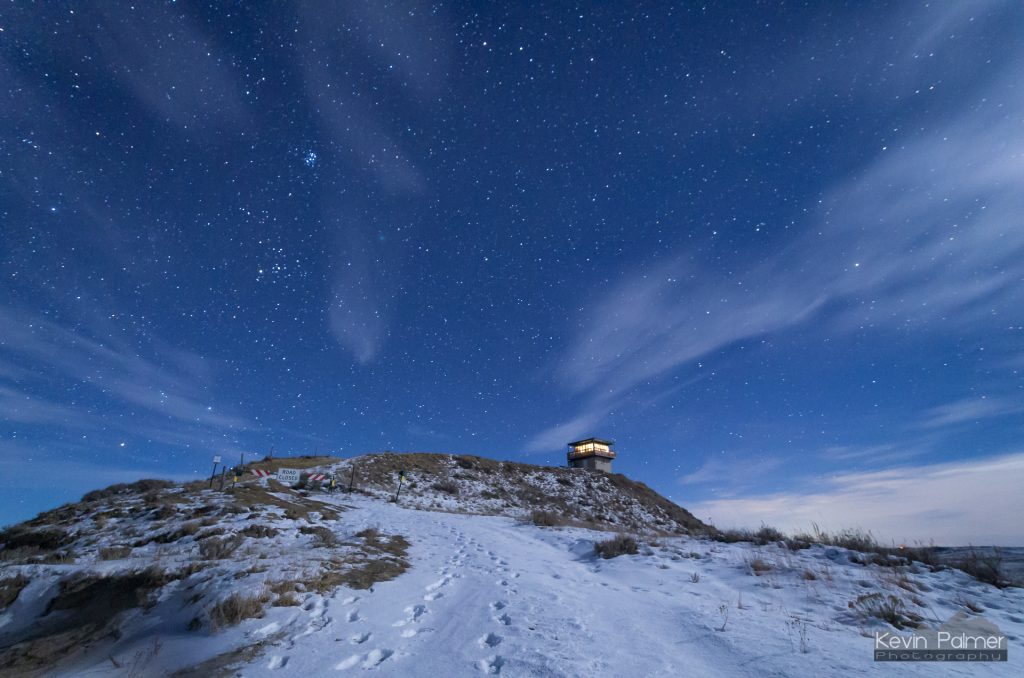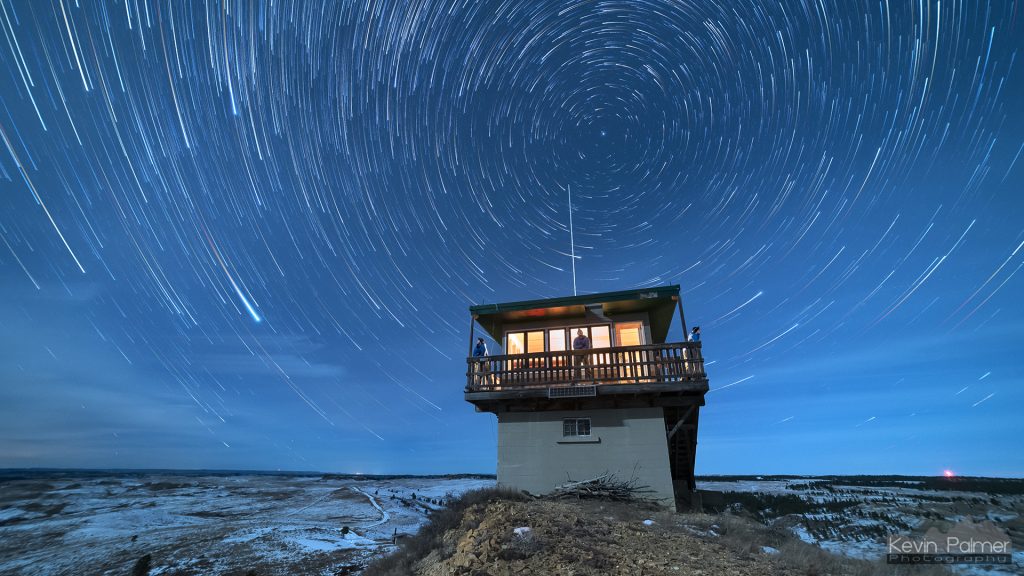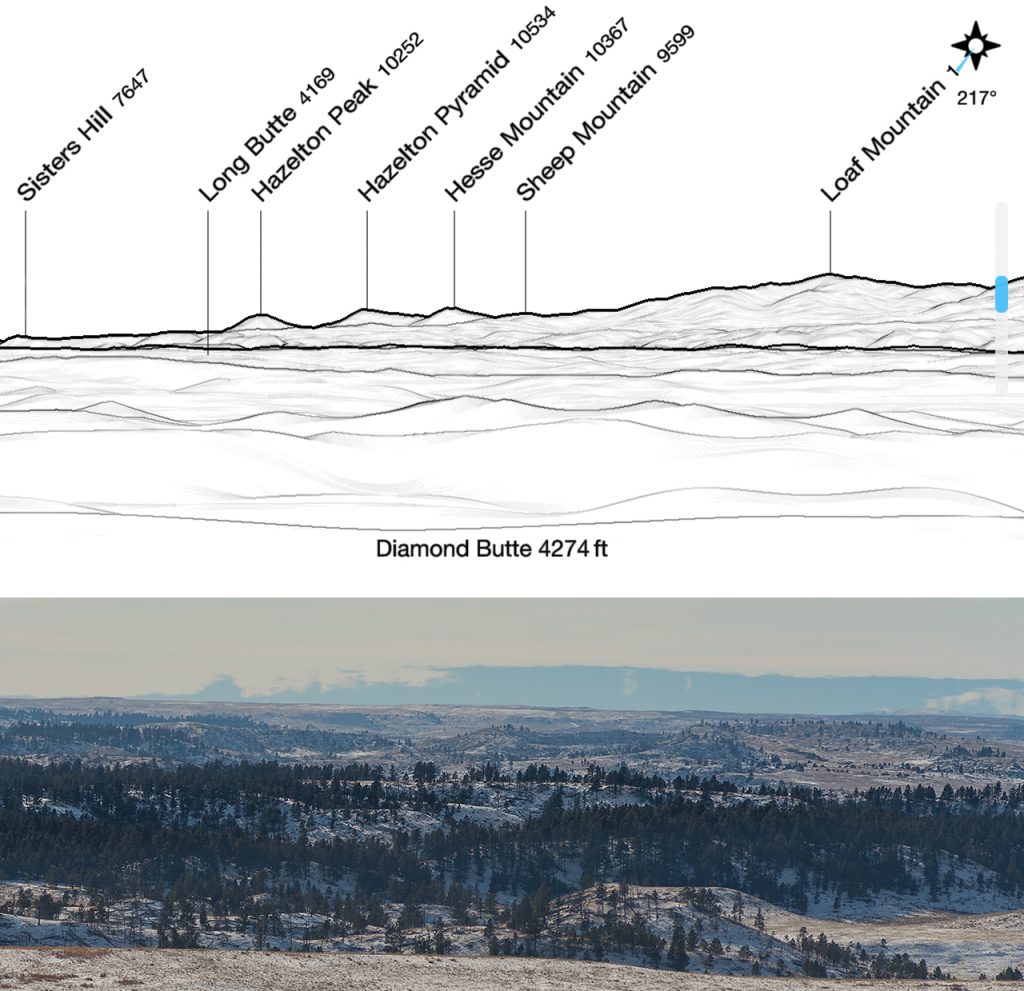345 Meteors – Geminids at Diamond Butte
December 15, 2018
Every year in mid-December hundreds of meteors fall from the sky in what is the most active meteor shower of the year. The moon phase was favorable for viewing in 2018, setting at 10:30PM on the evening of the 13th and leaving the rest of the night dark. So I made plans to go somewhere with a dark sky and a great view to photograph the astronomical event. A fire lookout tower is one of the best places to watch the stars, especially in the winter. Having a place to warm up and get out of the wind while my camera is outside taking pictures is invaluable. It’s much more comfortable than sleeping in a tent or in my car. And you just can’t beat the views.
Many fire lookout towers are closed in the winter. But Diamond Butte in southeast Montana stays open all year, even if snowy roads make it difficult to reach. It’s not in the mountains, but Diamond Butte is among the piney hills and grasslands of the Custer National Forest. From where I live in Sheridan it’s a 2.5 hour drive, the majority of which is on dirt roads. The propane stove, heater, fridge, and lights make it more luxurious than other forest service cabins and fire lookouts I’ve stayed at, although there’s still no running water or electricity. Most others use wood-burning stoves for heat, which is difficult to keep going when you’re solo, especially if you expect to get any sleep.

I arrived shortly after 4PM. The roads weren’t too bad, just a bit icy. But I did put on tire chains to make it the last 1/2 mile to the lookout where the snow was drifting more. But that’s mostly because I wanted the practice with the chains. When I climbed up to the tower I found the keypad dead and I couldn’t get in. So I called the forest service office, and a ranger had to come out to help bust open the door. The keypad needed new batteries, and it was after 6:00 by the time I finally got my stuff inside. But I didn’t mind since I wasn’t in a hurry. This wasn’t the first time I’ve had problems getting in, so I recommend arriving early if you plan to visit. There was an incredibly colorful sunset while I waited.


In the evening, moonlight and passing clouds hid any meteors from view. But that was OK, meteor activity typically doesn’t start picking up until after midnight anyway.

After a short nap, I started shooting again at 1AM. I had 2 cameras with me, and my goal was to capture meteors in every direction: north, south, east, and west. My cameras were shooting continuously for 5 hours, capturing nearly 1,300 images. I counted a total of 345 meteors in them. But since that’s a bit much to post online, I combined the meteors into 4 composites. There is no easy way to make these. It’s a painstaking process looking through every image to find the meteors, opening them in Photoshop, selecting them using the lasso tool, and pasting them onto a base layer. I wrote more about how this is done in the article, How to Photograph a Meteor Shower. But after many hours of putting together these stacks, they better convey just how prolific the meteors were, in a way that no individual image can.




I’ve been shooting meteor showers for 6 years now, and this was easily the best one I’ve ever seen and captured, beating out the 2016 Perseids. I was glad that the clouds mostly stayed away in the morning hours. Even though I didn’t need to, I had the fire lookout reserved for a 2nd night. It was nice to have an extra day to recover from the lack of sleep, relax, and enjoy the views a little longer. I didn’t have any luck capturing meteors on Friday night, since clouds moved in again after the moon set.

Throughout the day, I watched a really cool optical distortion effect known as a Fata Morgana. The Bighorn Mountains were 85 miles away, and the peaks were constantly changing shapes and becoming distorted. This was especially noticeable in binoculars. The effect is caused by an atmospheric inversion, when a layer of warm air is found above a layer of colder air near the ground. This forms an “atmospheric duct,” which acts as a lens, refracting the light and producing a superior mirage. Friday evening brought another decent sunset, although not quite as colorful as the day before. The optical effect slowly wore off.




The next morning brought a deep red and pink sunrise, which I enjoyed before packing up. Before leaving the Custer National Forest, I went on a 6 mile hike to find the Yager Butte fire lookout. It was abandoned long ago, and is in very poor condition. After that I took the longer way home, stopping for lunch in Ashland.



